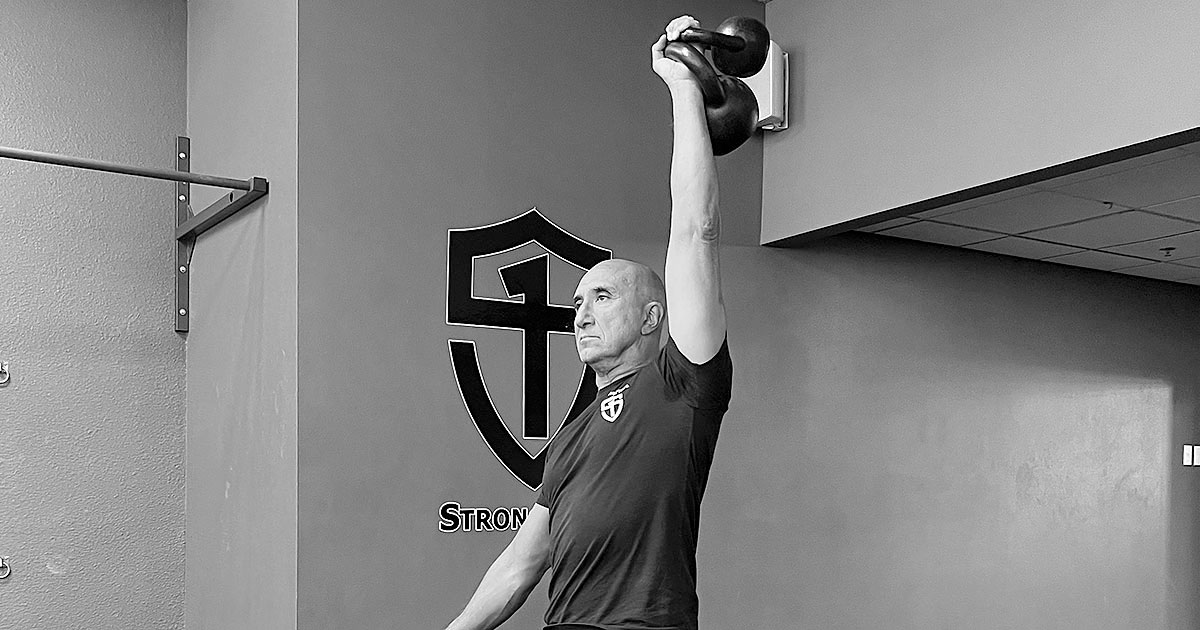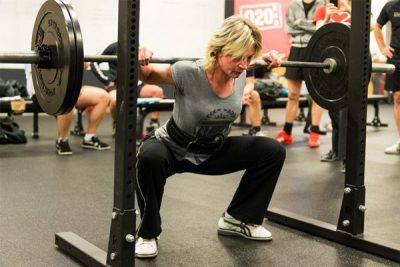
Most athletes know kettlebells have many benefits, especially the ballistic skills (e.g., the swing, snatch, and clean) which are almost impossible to do with any other tool. However, what may be less known is that kettlebells give us the opportunity to improve grinds as well as develop strength in the process.
One of those grind movements is the kettlebell military press. The benefit of the kettlebell military press over the barbell military press is the ability to do unilateral work, allowing for greater trunk stabilization and a more natural pressing pattern. Compared to an overhead dumbbell press, the kettlebell military press requires a higher level of stabilization of the shoulder and trunk due to the offset nature of the kettlebell. There is, however, a problem encountered with kettlebells: the incremental jumps between sizes. Because the gap between each kettlebell size is usually several kilograms, it is probable to hit some kind of plateau for a long period of time before being able to jump up to the next size. Protocols like “The Rite of Passage” and the StrongFirst online course “VICTORIOUS” have been designed to help transition to a heavier kettlebell while improving pressing strength. I would like to list a couple of other strategies that can also help improve various aspects of the kettlebell military press and own the transition to the next kettlebell weight.
Strategy #1: Changing the Base of Support
A good press requires perfect structure. It’s not only a matter of tightness, whole body tension, and trunk activation, but also making sure there is no leg movement involved while pressing. When things get heavy up top, there is a natural tendency to slightly—sometimes unconsciously—use a bit of leg drive to assist the press. When this happens, it becomes a push press instead of a strict press, defeating the whole meaning of the word “strict.” The following drills can help create maximum lower body tension while improving trunk/spinal posture during the press.
Pressing in a half-kneeling position
This can be done in a contralateral (pressing on the opposite side of the lunging leg) or an ipsilateral way (pressing on the same side of the lunging leg). Both options offer different levels of difficulty in terms of balance and lateral stability.
Tips:
- The front lower leg should be vertical.
- The abs and glutes should be contracted to maintain a neutral spine.


Pressing in a seated position
There are several options for pressing in a seated position. They are listed in order of difficulty:
- Cross-legged sit
- Z-sit
- Pike sit
The cross-legged position is very stable, the Z-sit position requires more hip mobility and lateral stability, and the pike position should only be used when you can maintain a neutral spine from sacrum to neck. Working on these different seated positions helps fight the natural tendency to lean back while pressing because they require strong internal bracing and postural alignment.
Tips:
- Work with a lighter kettlebell first.
- Make sure that you work on all variations of these positions (left or right leg in front in the cross-legged sit position, left side or right side in the Z-sit position).



Strategy #2: Stabilizing the Shoulder Joint
A strong shoulder needs to first and foremost be a stable shoulder. One way to achieve this goal is to groove the press pattern by challenging it from different angles.
Double kettlebell one-arm press (aka, the stacked press)
Pressing two kettlebells in the same hand by stacking them is one way to intensify the weight without increasing it. Not only does the stacked press work grip strength, but it also changes the center of gravity making it harder to press. In a nutshell, pressing a 20kg and an 8kg kettlebell in one hand not only feels heavier than just pressing a 28kg kettlebell, but it is also a great drill for those who don’t have an optimal wrist position while pressing. In addition, it is a great solution for someone who doesn’t have heavier kettlebells.
Tips:
- To start, make sure one kettlebell is a lot smaller than the other.
- A bigger difference in size will make it easier to keep both kettlebells in one hand.

Example of a Training Protocol
Let’s say a student hits a plateau and wants to press a 24kg kettlebell on both sides. The right arm is strong enough to press the 24kg but lacks stability. The left arm can only press a 20kg kettlebell for reps.
General rules:
- All the work is done using a 16kg and a 20kg kettlebell.
- Presses are only trained every other day.
- Each training session incorporates some heavy presses and some of the drills outlined above.
- There is plenty of rest or active recovery between sets of presses.
Session A:
- 3 sets of 5 presses on each side with a 20kg kettlebell
- 5 sets of 5 presses on each side with a 16kg kettlebell, changing the base of support (half-kneeling, tall kneeling, etc.)
Session B:
- 1 set of 5 presses on each side with a 16kg kettlebell
- 1 set of 5 presses on each side with a 20kg kettlebell
- 2 sets of 4 kettlebell stacked presses on each side (ideally a 16kg and a 4kg kettlebell)
- 2 sets of 4 bottom-up presses on each side with a 16kg kettlebell
- 1 set of 5 presses on each side with a 20kg kettlebell
Remember that these drills are only designed as tools to break through a plateau. They are steppingstones to a more solid and well-rounded military kettlebell press (this can also work for the barbell military press). Pressing a heavy load overhead requires upper body strength, shoulder mobility, and trunk stability. These drills are not meant to be used as your mainstay press regimen for an extended period. Progress is usually relatively slow and not being able to press a heavier kettlebell can be frustrating. This is the reason I use the suggested drills with my students. It helps them to break a plateau and demonstrates that progress can take many forms. If your military press has hit a plateau, applying these drills to your training will help you build a stronger, more stable press.







